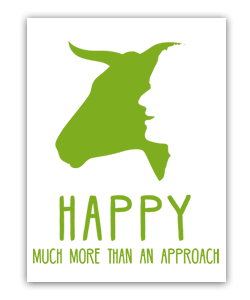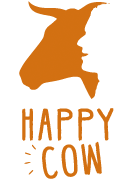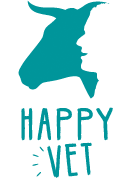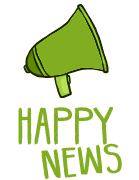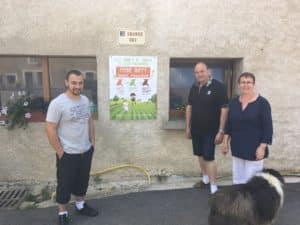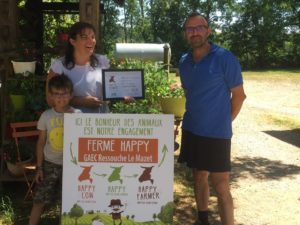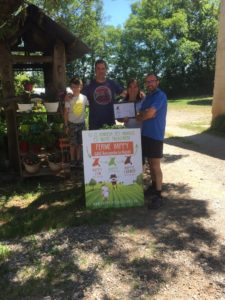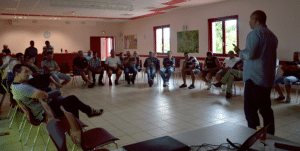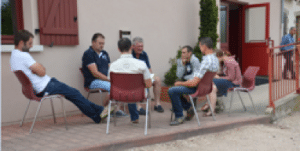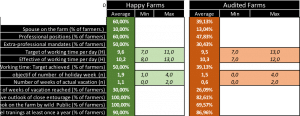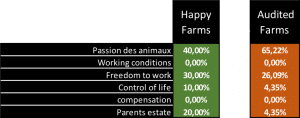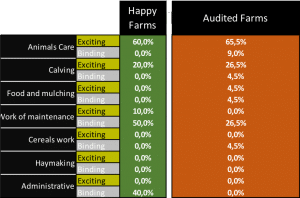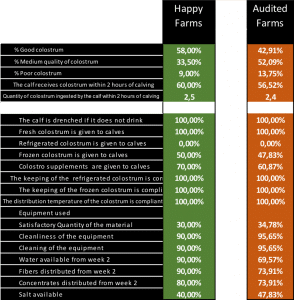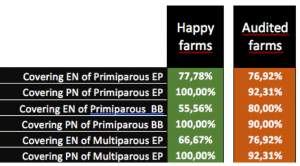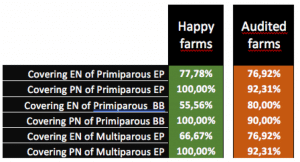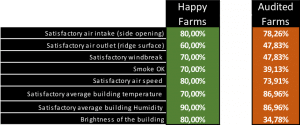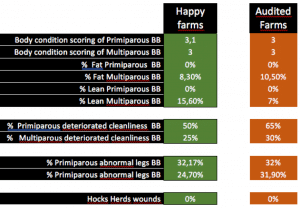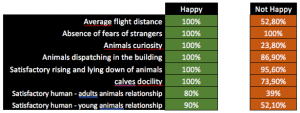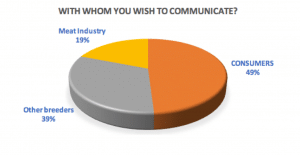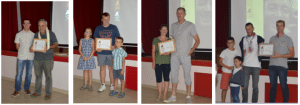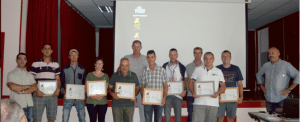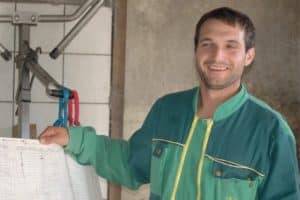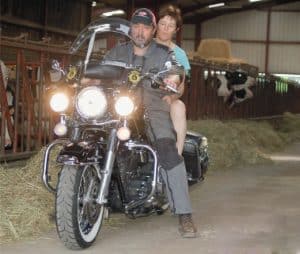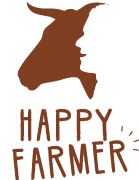Discover the approach
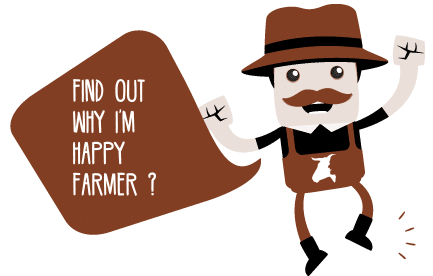
« Since I have been settled, no live calf has died in the farm » GAEC Brenans – Jura
« Each morning I go to work in whistling » Benoit Duffaut – GAEC du Pont – Loire
« i finally got rid of my stress, my cows lie down easily, their movements are much quiet and I have go back to work » EARL Girod – Jura
« In the herd, the Q fever moves around. There have been positive results. Despite everything and without any antibiotics, I have no deliverances, no metritis and no abortions » – Fabien Coulon. GAEC de la Gravaise – Saône & Loire
« The more my cows make milk and the better they fill! Is it not wonderful !…» – Rolland Fond – GAEC de la Héronnière – Vosges
Happy farmer: much more than a breeder!
Breeders who make the happiness of cows their reason of being.
We have sought to reveal their secrets. Often, nothing exceptional but the establishment of a careful management. Herd monitoring protocols are simple and effective but mandatory and defined with veterinarians; The breeders axquire these practices and put them in place on a daily basis.
Preparation for calving, thermal comforts of milk, breeding of calves, ventilation of nurseries … bring an immediate and a very important returns on investments, animal wellbeing always go hand in hand with zootechnical performances.
Veterinarians as well as breeders have a common wish: no longer undergo emergencies, anticipate problems by providing technical, food and dietary resources. Building, nutrition, health, everything is audited. Veterinarians are emerging from their role as emergency doctors and breeders do not hesitate to solicit them on all sorts of questions.
These practices, then compiled in a database, constitute our repository of “good practices in breeding ensuring the happiness of animals and men”
Happiness, a new partnership between breeder and veterinarian Happy.
New Happy Farmers !
An Example in la Loire
If relationship between the veterinarian and his breeder may be tense, Le Saint-Germain-Laval office does not seem to be the case. Rather than limiting his actions to veterinary medicine act, Roland Van Unen chose to work on prevention. This is manifested by systematic trimming (ideally at drying), follow-ups of reproduction and advice in comfort, management and feeding.
“Over the years, we have built a relationship of trust and the breeders ask us before investing. Concretely at the Gaec du Pont, we perform nursery plans, advice on the building design. The farmer remains the master of his business and the one who make the final decisions. “
At the Gaec du Pont, the veterinary expenses reach about €16,60 per 1,000 liters including preventive and curative actions. Thus, from May 2015 to May 2016, claves medicines care sales represented 10% of vet office fees, and that of curative medicines for dairy herds about 27%. Curative acts (Caesarean sections and others) reached 17% of veterinary expenses, as are preventive measures. Finally, the sale of preventive products reprensents about 28% of the global expenses. “”We have as much costs of prevention as of curative care””, concludes Roland van Unen, who would like to have the same ratio in the other farms.
“It’s more pleasant to work upstream than to intervene in an emergency. As a veterinarian, I feel more useful, “he says.
HAPPY FARMERS in the CHAROLAIS AREA
Télécharger l'article (PDF, 2.78MB)
The first feedback meeting HAPPY Beef Cattle took place in Andelaroche (FR-03) on July 26, 2017.
28 breeders audited during the winter were present as well as their veterinarians from the beginning of the meeting and 40 other breeders joined them in the late afternoon
This was an opportunity to introduce the Happy approach and to work with breeders and veterinarians on the animation to be implemented around the happiness of humans and animals in order to build a collective project and especially by involving the breeders from the starting of the project.
The work was done in small groups of 6 to 7 breeders so that everyone could take part in the debates.
An approach which shared experiences carried out in breeding
In a context of denouncing breeders more than to value their work, it would seem important to us to highlight the success of many of them and the relationships that farmers share with animals. After two years of initiating the process in beef cattle farms, we began the audits last winter in in breeding farms at the Charolais region.
The Happy approach is based on the identification of the happiness of animals and farmers in breeding. We define it by studying 130 criteria.
For breeders, the concept of happiness is similar to the performance of the herd: the absence of a health problem in the herd is necessarily a positive value for the breeder, as well as the achievement of the set goals: vacation weeks, working hours Per day, level of EBITDA ( earnings before interest, taxes, depreciation, and amortization ) and also compensation.
For animals, all aspects of livestock production are analyzed: diseases: their number and their management (prevention, vaccination strategy), zootechnical results: breeding performance, calves dispatching, animal management: management of calving, Colostrum, allotment, dehorning, access to food, water. Their body condition is measured, as well as signs of injuries, cleanliness and filling of the rumen, this latter indicates the feed intake satisfactory and the access of the animal to food.
We also study the building: ventilation, luminosity, floor coverings, surfaces per cow, number of water access points, areas for animal practice and quality of sleeping. We perform the knee and spinning lady tests. The Knee test is to let them fall to their knees, if the operator feels a pain or was left with wet knees, this is not satisfactory, neither for the farmer nor the animal. The spinning lady test is to try to make a complete turn on a foot. Under normal conditions, it is impossible to make a quarter turn, in a building with slick floors, it is possible but not satisfactory.
We also assess the behaviour of animals: their flight distance, their behavior towards a stranger, their curiosity for the human being, their dispatching in the building, the docility of the calves, and the presence of aggressive behavior between animals. All these points reflect the social life to farmer and between animals and also the quality of human-animal and animal-animal interactions.
The Happy approach is also the opportunity to compile the best practices of those who limit the problems as much as possible and who live an extraordinary adventure with their animals.
In our database are therefore collected the practices of HAPPY FARMERS. We thus have a database that allows us, during the trainings, to rely on data from the field, for both the practices to be set up and for the objectives to be reached. The guidance is more credible, the objectives achievable and our recommendations reinforced.
What are the characteristics of breeders?
Description of the farms
Table 1: Livestock description: Livestock structure
Very close proximity breeding, a trend to fewer cows but older in the Happy Herds.
Table 2: description of the farms: the farmer in his farm.
Less weeks of vacation and more working hours per day, this is the conclusion shared by all breeders. With less than 2 weeks of vacation per year and nearly 60 hours of weekly work, the reduction in working time has not yet reached beef cattle farms. It should be pointed out that half of the breeders Happy nevertheless declared that they had reached their goal of work per day.
A trend towards emotion was observed. Good assumption, at a higher proportion, a positive outlook for the breeder entourage and the wide public. Cause or consequence of the greatest hosting practice in their farms?
Description of the breeders
Table 3: Description of the breeders: motivations
The passion for animals and the freedom granted by the business represent for both groups more than three-quarters of their excitement for their professional choice.
Table 4: Breeders descriptions: most important tasks
Unsurprisingly, animal care and calving are considered to be highly exciting breeders, while maintenance (buildings, equipment) and administration are considered constraints.
When asked about future developments, %80 of the Happy breeders and %91.30 of the audited breeders declared that they plan to change their structure.
Health and zootechnical results
Table 6 : health results.
No difference observed between breeders. This is a breeding with excellent technical results.
These excellent results are partly explained by the practices of calf breeding:
Table 6 : practices of calf rearing
These practices show good control of calf rearing. It may be noted that if the number of specific material for colostrum seems insufficient, their cleanliness and the cleaning technique are excellent. Contamination by bacteria is a major factor in the failure of immune transfer, so it is important to ensure containers as clean as possible. In dairy farming, the practice of pasteurization is tending to take over.
Table 7 : Reproduction
Reproduction is controlled in both groups. We can point out a trend towards achieving more frequent goals among Happy.
These very positive reproductive results are to be compared with food practices.
Table 8 : Food
EN: Energy Needs; EP: End of pregnancy; PN: Protein Needs; bb: Beginning of breastfeeding, OE: Oligo-element.
Contrary to what is usually observed, it may be noted an excellent coverage of the protein needs and under-coverage of the energy needs which seems, for the latter point, more acute in the group Happy. Conversely, the coverage of oligo-elements and vitamins seems to be better respected among the Happy.
Table 9 : Food balances
The technical results with the conventional parameters doesn’t show difference in our sample between breeders who have validated the Happy criteria of those that are being acquired.
Results on water are less efficient.
Table 10 : Water
Water is a constant in our audits and is often poorly controlled in animal breeding: the equipment, the flow, the number of drinking troughs and their accessibility often represent risk factors for animals. This is also the case here with too few analyzes carried out and too often insufficient flow.
Description of comfort and buildings
A crawl space of more than 1 month is achieved in more than 80% of the Happy breeders (against 52.2%)
The Knee test is to let them fall to their knees, if the operator feels a pain or was left with wet knees, discomfort or feel any moisture. The test is then clearly “positive”.
This knee test shows a difference between farms
These differences are partly due to the design of the buildings.
Table 12: Ventilation of Buildings
The results, quite similar in both groups and demonstrating once again a good mastery, show a trend towards a better atmosphere (Exit, Windbreak, Smoke and Brightness) in Happy breeding.
Animals
Table 13: scoring of animals
Here we find the manifestation on animals, of the perfectible atmosphere noted above. The point of cleanliness is to be observed. As indicated in the graph, the health impact is very low because the other risk factors are controlled but this situation can lead to a negative perception by people outside the breeding or even customers of his breeding.
Table 14 : Animals behaviour
It is here, with the achievement of the set objectives, that the more significant differences are found between the two groups.
The average flight distance is measured with the extended arm at 45 ° (relative to the body) and the distance at which the animal begins to step back. The test is usually done with animals with the feed fence. Animals curiosity is considered normal when about 10 cows are around the operator at least 2 minutes. The docility of the calves is evaluated by noting the number of calves that must be approached to reach 2 of them. A maximum of four is tolerated, beyond that, the situation is qualified as unsatisfactory. Interactions with animals are evaluated by validating the time devoted specifically to these tasks: vocal interactions, strokes, passage in the middle of the animals.
Our audited sample of breeders of last winter is not representative of the Charolais region breeders. These are breeders with excellent performance and good practices already well established.
After all, there is an emerging trend between those who are already certified Happy and those who will be certified soon. The main differences are mainly based on the behaviour of their animals and on their “mood” since they are plentiful likely to have achieved their objectives.
These results allow us to approve our survey and also allow to put into perspective the comfort of the animals, the zootechnical performances and the breeder’s fulfillment.
The second part of the day was devoted to group work on the notion of happiness in breeding and the expectations of breeders.
What are the breeder’s envolvement ?
Graphs 1, 2, 3: breeders and communication
The involvement of breeders is total and intense! In a context of mistrust of the breeding, even of claim, the breeders wish to take the floor again.
After too long delegated communication, breeders want to resume control “our grandparents have fed the world and journalists accused us of destroying the planet, we must change that! “.
They are aware of their current limitations “We do not know how, we have not learned” as well as their arguments: “our genetics, our landscapes, the control and the quality of feeding our animals are assets to showcase”. “We work naturally, we use high quality products of that we produce on the farm”
It remains to find again the habit of sharing “we should meet more often between breeders, share our know-how and associate us to communicate”
Transparency does not frighten them, they even want to make an argument “we have nothing to hide, on the other hand we must acquire a good pedagogy! And” targeting children, it is the children who educate parents now! ”
Graph 4 : With whom communicate ?
The Open Days are privileged, but also social networks, regional newspapers and the mainstream press. Regarding high stakes for the sector, it is important of doing collective communication and prevent any individual communication as repeatedly been shown to be ineffective.
Happiness is a topic that can serve as a teaser even if “the notion of happiness is surprising, not usual, but not embarrassing” All of them spotlight their passion for animals and their businesses: “even if the workload is important, we can still have teatime snack with our children, it is a luxury is also that happiness. Few, if any breeders can do it ”
All the farmers interviewed say they care about the happiness of the animals.
The Happy approach meets their expectations and corresponds to the achievement of their work “we must set up a Happy! “ We need gratitude ”
This happy first suckler day has laid the foundation of the joint work to be set up the upcoming months. New breeders will join the Happy Farms network, new breeders will be audited.
Together we will work on communicating the quality of the work done, man-animal relations and the happiness of all in breeding to make it a Value Added for all: from animal to consumer.
It is important to provide consumers with understandable benchmarks and to allow them, through their purchases of selected products, a respectful production of human and animals.
At the end of the day the breeders HAPPY were awarded their diploma recognizing the quality of their performances.
Within a few weeks we will also give them the “marketing package” to initiate the communication on the happiness of the animals: business cards, the Happy notebook, leaflets explaining the approach and also posters!
Testimonials / Feedback from experiments
In Saône-et-Loire, the partners of Gaec de la Gravaise must manage a dairy farm of 95 Montbéliardes, exploit 425 ha of UAA ( useful agricultural area) and lead a suckler herd of 105 Charolais and Limousines. To this is added breeding of 110 goats. To anticipate the difficulties, the four breeders rely on the comfort … Continue reading “The Happiness of the cows and serenity of the breeders”
200 milkings per day, 200 rejections and an average production of 35 kg per day: this is the happiness equation of the Holstein Gaec du Roya. The implementation of precise but simple care protocols, the choice of animal welfare guarantee the breeders a sort of serenity. I am the conductor of my breeding, “Vincent Collardé … Continue reading I am the conductor of my breeding
